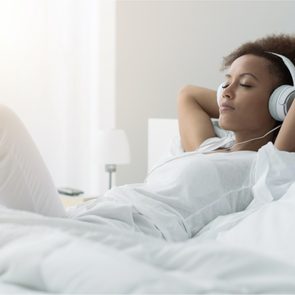The Health Benefits of Light Therapy (Beyond Seasonal Affective Disorder)

Research is supporting exciting new applications for light therapy.
When seasons shift and the days get shorter, people all over the world experience the so-called winter blues. Some of us also suffer from a more severe variety called seasonal affective disorder—a depression caused by a lack of exposure to direct sunlight. For this condition, scientists have found sitting for 30 minutes a day in front of a specially designed lamp that emits a bright white light can help. In fact, this treatment can be as effective as antidepressants—and a 2015 study found that it could even help patients whose depression is non-seasonal.
The sun emits different kinds of light, some of which are more beneficial than others. The shortest wavelength is ultraviolet and the longest is infrared; in between are all the familiar colours of visible light. Research into the benefits of light therapy has been taking place for more than a century. In the early 1900s, it was recommended for everything from treating tuberculosis to generating hair regrowth. But it became less popular after the discovery of antibiotics and the rise of the pharmaceutical industry. Plus, many of the extraordinary claims about the benefits of light therapy tested credulity.
Applications of Red Light Therapy
In the last decade, however, driven by a surge of encouraging trials, light therapy has made a comeback—including in clinics and hospitals. Red light in particular is being studied for its ability to help ease the symptoms of serious health problems, such as Parkinson’s, Alzheimer’s and carpal tunnel. (Learn to spot the early symptoms of Parkinson’s.) Even though many of these applications are still awaiting government approval, red light is already being administered in hospitals in Europe, Canada and South America to treat macular degeneration.
Red light’s special healing properties are linked to its ability to activate mitochondria, cellular structures that play a role in combatting these conditions. As Janis Eells, a professor of biomedical sciences at the University of Wisconsin-Milwaukee, describes it, light can give cells a “kick in the mitochondrial pants”—basically waking them up and prompting them to do their job.
Light therapy is being used in more common, everyday applications, too. Red and near-infrared light are capable of reaching cells beneath the skin to accelerate the healing of bruises and wounds. This treatment can be done at many beauty salons or with a home unit: people tend to expose themselves for five to 15 minutes once a day until the wound heals. (For a safe and effective treatment, it’s best to consult a doctor before using red light.)
Benefits of Blue Light Therapy
Blue light, which can reach just under the epidermis, is commonly prescribed by dermatologists—and administered at home or in the office—to kill acne-causing bacteria on the skin.
Research into Green Light
Green light is not as well understood, but a 2020 study from the University of Arizona indicates that it might serve as a preventive therapy for patients with recurrent migraines. After 10 weeks of self-administered exposure for one to two hours a day, patients reported an average 60 per cent reduction in pain. These are promising preliminary results, but medically approved clinical use is likely still a few years away, Eells says.
Now that we are beginning to understand how and why light can heal us, Eells is encouraged that we’re overcoming the skepticism that plagued light therapy in the past. “It’s not magic,” she says. “It really is science.”
Now that you’re up to speed on the benefits of light therapy, find out more ways to beat seasonal affective disorder.






